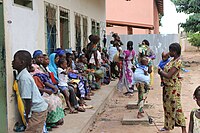
Photo from wikipedia
Abstract Background Development of group B streptococcus (GBS) vaccine is currently underway. In order to establish the immunization policy for the future, it is necessary to understand the basal immune… Click to show full abstract
Abstract Background Development of group B streptococcus (GBS) vaccine is currently underway. In order to establish the immunization policy for the future, it is necessary to understand the basal immune level of risk groups in each country. Methods Thirty serum samples were collected from each risk group (neonates/infants, pregnant women and the elderly) between August 2016 and July 2017 at Korea University Guro hospital. Serotype-specific opsonic index (OI) was assessed using GBS multiplex opsonophagocytic killing assay (MOPA) against serotype Ia, III and V, which are most prevalent worldwide. Results The mean age of neonates/infants, pregnant women, and the elderly was 1.3 months (range, 1–3 months), 31.9 years (range, 23–41 years) and 68.8 years (range 65–76 years), respectively. Baseline OI of each risk group measured by MOPA was shown in Table 1. The mean OI of serotype Ia was not significantly different among three risk groups (P = 0.156), but relatively lower in the neonates/infants group (mean ± standard deviation, 137 ± 278). For serotype III, the mean OI of neonates/infants (338 ± 623) was significantly lower compared with those of pregnant women (1,377 ± 1167) and old adults (1,350 ± 1741)(P = 0.002); Overall 60% of neonates/infants showed OI below 100. As for the serotype V, OI was particularly lower in neonates/infants (161 ± 445) compared with the elderly (3,669 ± 5,597) and pregnant women (9,414 ± 6,394) with statistically significant differences between three risk groups (P < 0.001). Conclusion Considering the relatively low OI of neonates/infants despite high maternal titer, intrapartum GBS vaccination might be required to ensure efficient placental transfer of serotype-specific GBS antibodies with high avidity.Table 1. Comparison of Baseline Opsonic Indexes Between Risk Groups: Mean Opsonic Indexes and 95% Confidence Intervals Serotypes Groups Opsonic Index (Mean) 95% CI P-Value Ia Neonates/infants 137 33–241 0.596 Pregnant women 285 17–552 The Elderly 231 3–459 III Neonates/infants 338 105–570 0.002 Pregnant women 1377 941–1813 The elderly 1350 700 - 2000 V Neonates/infants 161 -5–327 <0.001 Pregnant women 9414 6825–12003 The elderly 3669 1579–5759 Disclosures All authors: No reported disclosures.
Journal Title: Open Forum Infectious Diseases
Year Published: 2018
Link to full text (if available)
Share on Social Media: Sign Up to like & get
recommendations!